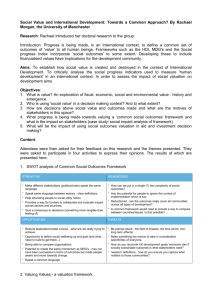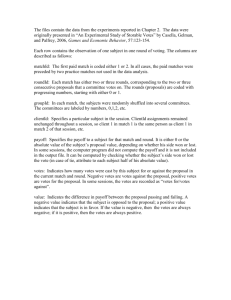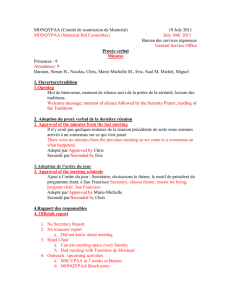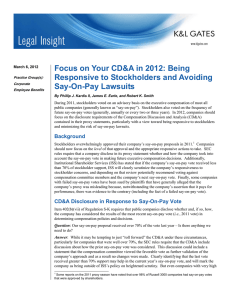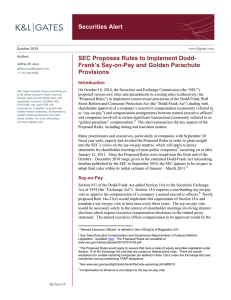Don`t Take Favorable Votes at Face Value
advertisement
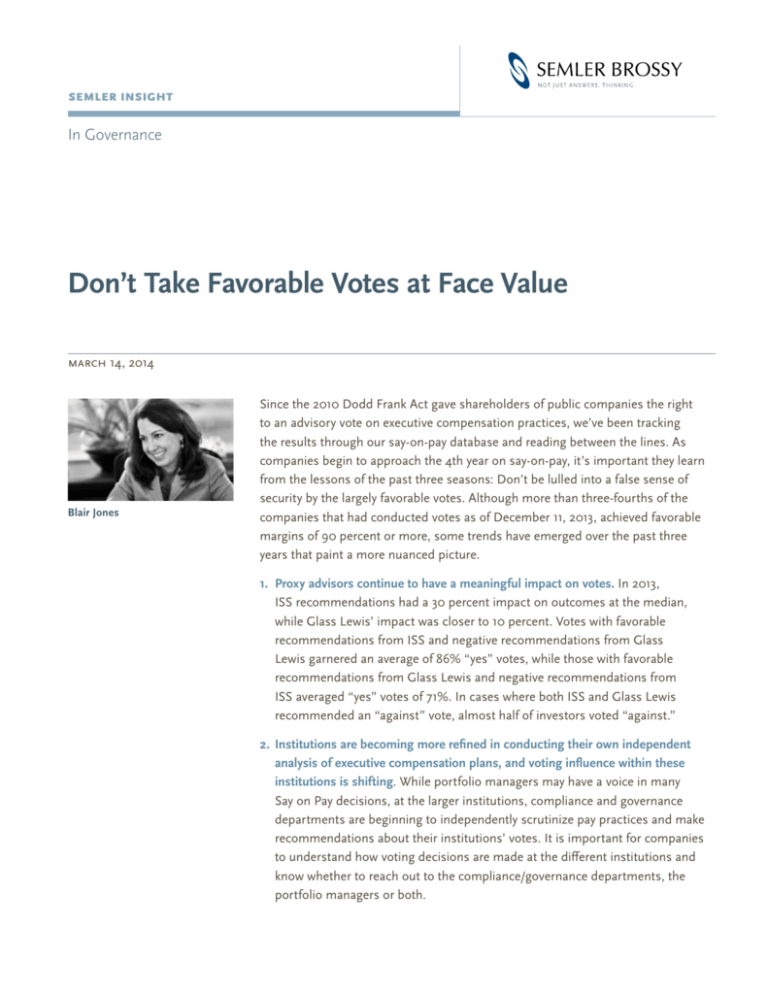
Semler Insight In Governance Don’t Take Favorable Votes at Face Value march 14, 2014 Blair Jones Since the 2010 Dodd Frank Act gave shareholders of public companies the right to an advisory vote on executive compensation practices, we’ve been tracking the results through our say-on-pay database and reading between the lines. As companies begin to approach the 4th year on say-on-pay, it’s important they learn from the lessons of the past three seasons: Don’t be lulled into a false sense of security by the largely favorable votes. Although more than three-fourths of the companies that had conducted votes as of December 11, 2013, achieved favorable margins of 90 percent or more, some trends have emerged over the past three years that paint a more nuanced picture. 1. Proxy advisors continue to have a meaningful impact on votes. In 2013, ISS recommendations had a 30 percent impact on outcomes at the median, while Glass Lewis’ impact was closer to 10 percent. Votes with favorable recommendations from ISS and negative recommendations from Glass Lewis garnered an average of 86% “yes” votes, while those with favorable recommendations from Glass Lewis and negative recommendations from ISS averaged “yes” votes of 71%. In cases where both ISS and Glass Lewis recommended an “against” vote, almost half of investors voted “against.” 2. Institutions are becoming more refined in conducting their own independent analysis of executive compensation plans, and voting influence within these institutions is shifting. While portfolio managers may have a voice in many Say on Pay decisions, at the larger institutions, compliance and governance departments are beginning to independently scrutinize pay practices and make recommendations about their institutions’ votes. It is important for companies to understand how voting decisions are made at the different institutions and know whether to reach out to the compliance/governance departments, the portfolio managers or both. Seml er Insigh t | Don’t Take Favorable Votes at Face Value | March 2014 3. No company is safe. Strong support in one year is no guarantee of future say-on-pay success. Most companies that failed in 2013 had large year-over-year drops in support. And two-thirds of those saw a drop in support of 30% or more, suggesting how widely a vote can swing from one year to the next. Even among companies that passed, such drops can be significant: 90 companies saw declines in “yes” votes of 20% or more from 2012 to 2013. And boards that feel safe for the future should consider: a small drop in one-year total shareholder return (TSR) versus a given peer group of 14-18 companies could drive a company into the lower quartile of the peer group on ISS’s relative degree of alignment (RDA) calculation (which will be measured over a three-year time period beginning in 2014). If the board is proposing even median pay in those circumstances, it could trigger a “medium” concern from ISS. What lies behind negative recommendations from proxy advisors and “no” votes? Sometimes, the answer is simply poor company performance. But such recommendations and votes may also express dissatisfaction with elements of the executive pay package, including such practices as legacy gross-ups; retention awards, particularly those without some kind of performance requirement; and/or CEO exit packages which include awards beyond what is required by policy or contract. Among S&P 500 companies that received an “against” ISS recommendation related to CEO exit package provisions and then received less than 80% say-on-pay support, ISS cited concern about one or more of the following: 2 Proxy advisors are also questioning the rigor of performance metrics (e.g., using the same metrics in both the annual and long-term plans) and goal-setting. ISS, for example, took a large healthcare company to task for six consecutive years of at- or above-target payouts under multiple incentive programs. In ISS’s opinion, the company had failed to demonstrate the goals were firmly anchored, both backward and forward, and how their achievement linked to driving shareholder value. Instead of waiting for a “no” vote or a significantly lower favorable vote, companies should be proactive in addressing pay issues. Companies that wait until their votes deteriorate are virtually compelled to act, often defensively adopting solutions such as relative Total Shareholder Return (TSR) as a pay-for-performance measure. Relative TSR can be an effective compensation tool, but in some cases, adopting it simply as a fallback position may not be right for the business and/or it could result in pay practices that are less defensible over time than those that it replaces. The good news is that while no company is safe, companies can bounce back from a disappointing say-on-pay vote. From 2012 to 2013, 135 companies (7%) had their vote results improve by more than 20%. Among companies that failed in 2012, 75% have passed in 2013. Companies that received “for” votes in the 50-70% range in 2012 received, on average, 16% more support in 2013. • Severance payments that deviate from standard separation terms However, rebounding from a low-majority “for” vote may require extensive effort. S&P 500 companies that passed their 2012 say-on-pay votes with only low-majority support — 50-60% — undertook a variety of activities to repair the damage. Virtually all of the companies (95%) undertook shareholder outreach. In addition, companies also took the following actions to modify their pay plans: • Packages that total more than $15 million • Reduced summary compensation table CEO pay • Acceleration of vesting on equity • Continued vesting of in-cycle performance shares • Increased performance-based long-term incentive design • Large pension benefits, including the addition of years of service to the pension calculation • Introduced more formulaic annual incentive plan design 3 Seml er Insigh t | Don’t Take Favorable Votes at Face Value | March 2014 • Modified ownership guidelines • Established more aggressive performance targets • Eliminated excise tax gross ups • Adopted clawback policy • Introduced double trigger change in control Many companies that failed their say-on-pay votes in 2012 took similar actions. This suggests that companies passing with low-majority approval are as concerned to demonstrate responsiveness to investor concerns about compensation as companies that fail outright. Bottom line, with the continued volatility in say-on-pay votes, even companies with highly favorable votes may not want to wait to re-examine their pay programs and increase their outreach. For more information, visit us at www.semlerbrossy.com , or please contact: Blair Jones, Managing Director Semler Brossy Consulting Group LLC 1021 Hedge Row Clinton, NY 13323 212.388.9776 bjones@semlerbrossy.com Juliet Archer, Associate Semler Brossy Consulting Group LLC 10940 Wilshire Boulevard, Suite 800 Los Angeles, CA 90024 310.943.8371 jarcher@semlerbrossy.com © 2014 Semler Brossy Consulting Group LLC

